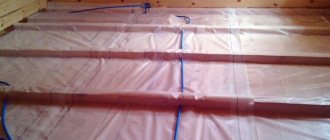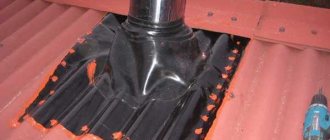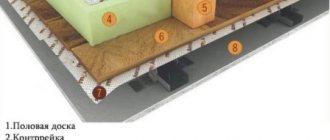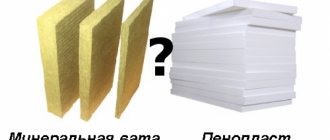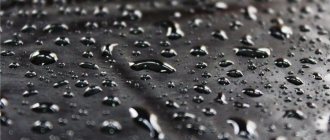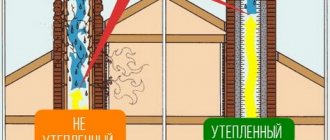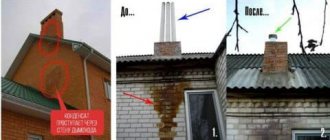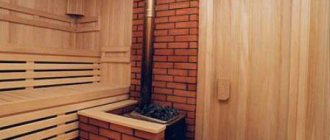Consequences of an unsealed joint
To bring the chimney through the roof, a larger diameter is cut out into it, so that a gap remains between the walls of the chimney and the roofing material. Regardless of the width of the gap, it is a big problem faced by homeowners and builders. To eliminate this defect and protect the under-roof space from the penetration of atmospheric moisture, use seals, aprons, collars, made by yourself or purchased. An unsealed gap between the roof and the chimney pipe is fraught with the following consequences:
- Increased wear of roofing material. Most roof waterproofing materials offer better protection against moisture penetration from the outside. Moisture penetrating through an unsealed gap gets onto the inner surface of the roof and eventually destroys it.
- Reducing the service life of the rafter frame. The pouring water hits the elements of the rafter frame, which are made of wood. This leads to rotting and premature destruction of the rafters.
- Reduced insulation efficiency. Roof insulation materials lose their properties when wet, becoming less effective.
- Increased humidity in the attic. Increased dampness in the attic causes heavy, stale air and negatively affects the interior decoration of the room.
Clearance to prevent rafters from catching fire from a heated pipe
Important! The method of sealing the gap between the chimney and the roof depends on its size, the type of roofing material used and the shape of the chimney. If the distance is less than 5 mm, it is quite possible to get by with a heat-resistant silicone-based sealant. You can close a gap whose width is 1 cm or more using cement mortar, an apron, or a special sealant.
Basic methods of sealing roof pipes
When building a house, in particular during roofing work, a hole is always left for chimney and ventilation pipes. And no matter how hard the builders try to lay the roof close to the chimney, gaps still remain. Moisture penetrating through them can create a lot of trouble for home owners.
This is fraught with a reduction in the service life of the roof, damage to supporting structures and simply uncomfortable living. Errors in sealing can lead to the following consequences:
- leaks, accumulation of large amounts of water inside the house, etc.;
- the process of rotting caused by excessive levels of moisture in places where there should not be any;
- disruption of the chimney itself, lack of draft.
In order to avoid all these unpleasant consequences, it is necessary to take care in advance of the correct sealing of the chimney on the roof. Fortunately, now there will be no problems with either materials or sealing methods. There is a huge amount of special equipment and materials on the market for such purposes. As for the methods, it all depends on the type of roof, as well as the shape of the pipe itself.
Sealing with mortar
To seal the gap between the chimney pipe and the slate or tile roof, use moisture-resistant cement mortar and a decorative collar. This is the most affordable way to insulate the attic and rafters from moisture with your own hands. This requires dry mortar, water, a mixing container, steel corners and a collar. Installation work is carried out in the following order:
- The gap between the roof and the outer wall of the pipe is lined with stainless steel corners. If the chimney is oval or round in shape, you can use a rubber seal with an adhesive backing.
- A decorative collar made of galvanized steel is put over the chimney head and secured with self-tapping screws.
- A pre-mixed viscous solution is poured into the gap between the collar and the pipe and allowed to harden for 1 day.
- After a day, check the quality of the filling and the degree of hardening of the solution. A surface for liquid drainage is made from a sheet of sheet steel. To do this, a hole is cut out in it, the diameter of which corresponds to the size of the collar, put on the head and fixed with self-tapping screws.
Closing the gap using mortar and a decorative stainless steel collar
Creating formwork to isolate the target between the pipe and the roof using mortar
Important! To ensure that the structure is reliable and does not collapse during the first serious downpour, high-quality waterproof cement is used. Otherwise, cracks will appear on it, through which water will leak into the rafter frame.
How and with what to seal the gap between the pipe and the roof - different options for different materials
Installing a chimney is usually not a difficult process, however, in some places, such as floor crossings, some difficulties may arise. An important point is to ensure proper waterproofing. We will talk about this and other nuances related to how to seal a chimney pipe in this article.
Even if the pipe is placed as tightly as possible on the roof, minor gaps will still remain. When it rains, moisture will constantly enter the attic through them, which over time will lead to damage to the roofing structures. This is why roof pipe sealing is so important.
Sealing with a steel apron
To seal the gap between the chimney pipe and the roofing material with your own hands on roofs made of metal tiles and corrugated sheets, use special aprons. They are made of galvanized steel in the color of the roof in the form of additional elements. With their help, you can reliably and aesthetically isolate the gap; to do this, proceed in the following order:
- Along the perimeter of the pipe, strips of waterproofing 30 cm wide are laid, bringing the edges up, fixing them on the wall with sealant or adhesive tape.
- To close the gap at the chimney outlet, metal wall profiles are used. The lower fastening flange is tucked under the roofing material and fixed to the rafters with silicone sealant with a moisture-resistant composition. The top shelf is attached to the pipe wall.
- Decorative textures are installed from galvanized steel with a polymer coating. It is a set of additional elements that are overlapped with each other and secured with self-tapping screws to the pipe and roofing material.
Scheme for attaching an apron to isolate the gap
Installation of a decorative apron
Important! You can make your own apron from sheet steel. However, factory products look more aesthetically pleasing and presentable. When working on the roof, special roofing screws are used as fasteners, equipped with a rubber headband, which, when twisted, flattens, closing the hole from water penetration. If there are no such screws at hand, gaskets are cut out of rubber using them with ordinary self-tapping screws.
How to ensure sealing of a chimney on a corrugated roof
Corrugated roofing is a good solution for protecting a building from weather conditions for many decades to come. This economical and reliable material is used for roofing in individual and multi-apartment housing construction, in the construction and repair of production areas or other facilities.
Correct sealing of the chimney on a corrugated roof is a guarantee of the safety of the entire structure. Work on waterproofing the joint between the pipe and the roof is carried out both at the stage of roof installation and during the repair (replacement) of the roofing or chimney.
Sealing with rubber aprons
Construction stores suggest using Master Flash rubber aprons or Wakaflex sealing tapes to seal gaps where pipes pass through a roof made of any material:
- Master Flash is an elastic penetration on a rubber base in the form of a stepped funnel, reinforced with aluminum mesh inside. It is suitable for roofs with any slope and any roofing material. The rubber apron reliably protects the gap from liquid penetration. To adjust the apron to the size of the pipe, it is cut to the required diameter. The apron is fixed to the slope with self-tapping screws, and to the pipe using a steel clamp.
Rubber passage Master Flash
Insulating the joint with an elastic apron Master Flash - Wakaflex is a rubber tape with an adhesive base. It is used to seal the joints of a soft roof with pipe walls. The inner side is reinforced with aluminum mesh. It has high elasticity, takes any shape, and is easily fixed to the slope. Wakaflex tape is used in combination with decorative aprons and collars.
Rubber self-adhesive tape Wakaflex
Insulation of the pipe passage through the roof with Wakaflex tape
Note! To eliminate large gaps, a fiber sealant is first compacted into them, and then filled with bitumen mastic or filled with foam. After this, the passage area is decorated with a decorative collar. Please note that collars are produced with a standard angle, which is selected in accordance with the slope of the roof slope and the diameter of the chimney.
The main condition for long-term operation of the roof is maximum tightness, which is achieved by isolating even minor gaps. Whatever sealing method you choose, remember that reliable protection against moisture penetration is more important than an attractive appearance.
Methods for sealing pipes
There are three main methods of sealing:
- using a metal collar;
- rubber inserts;
- membranes.
The first method is used on square or rectangular pipes. It is based on the use of corners that form an apron and a special tie to remove moisture. Next, we will consider an example of such insulation on a metal roof.
Rubber liners are used primarily on round bends, since their operation is based on the tight fit of the pipe, which prevents leaks.
Well, membranes are presented on the market mainly in the form of special tapes that have a sticky layer on one side, allowing all the cracks to be sealed very tightly.
Additionally, all methods should be divided into several groups, depending on the type of roof whose insulation is required.
Metal roofing
A rectangular brick pipe on a metal tile roof can be “packed” as follows:
- special steel elements are created, which represent the so-called apron (one L-shaped part on each side);
- these parts are inserted into pre-cut grooves in the pipe;
- the lower parts of the elements are attached to the roof;
- a “tie” is connected to the lower parts on one side - a special device that drains water in the desired direction;
- All cracks are sealed very tightly with special materials.
Installation of the roof itself should be carried out after all these stages have been completed and the drainage system has been routed to the right place.
This is one of the most common ways to eliminate gaps between a pipe and a roof. It is used almost everywhere, differing only in insulating materials.
Sealing a round pipe on a roof with a corrugated roof is best done using special devices. They may be called differently, but they are all one-piece caps that perform the same function as aprons.
- metal sheet with a hole;
- a truncated cone in place of the hole, made of hard or flexible materials.
Fastening such a device is much simpler than installing a tie on a rectangular pipe. Here it is enough to simply thread the chimney into the hole, and then fasten the pipe and cone with a special harness. To increase insulation, the mounting point is equipped with a reliable gasket that is resistant not only to moisture, but also to high/low temperatures.
The market offers consumers universal caps that can be hermetically adapted to their pipe. To do this, you simply need to cut off the excess part using one of the dimensional notches prepared by the manufacturers.
Caps made of elastic materials, rubber or silicone are very popular. They are stepped pyramids mounted on an aluminum base.
The use of such devices provides for very tight joints of parts, since the hole is left slightly smaller than the diameter of the pipe. A tension occurs, and as a result, a very reliable fixation around the pipe.
Tile roofing
The specifics of this type of roofing force builders to resort to other tricks in order to ensure reliable roof tightness.
In this case, sealing is carried out by using a special solution of sand and cement, which is placed in prepared steel collars. To ensure drainage, a special protrusion is created from the mixture in the collar itself. It is formed from the ridge side.
Slate roofing
On such a roof, the pipe is usually located near the ridge. In this case, tightness can be ensured using a steel sheet placed on the ridge. It’s just necessary to provide small bends at the location of the pipe, creating a kind of collar for the pipe.
This collar is fixed using an asbestos cement ring, which is attached to the pipe using a pin. All possible cracks are insulated with special materials.
This method is very effective in the pipe area, but the slate coating itself requires a special approach.
Soft roof
On a soft roof, there should be no problems with sealing. All that is needed is abutments made of roofing material and roofing tape. The connections are attached simultaneously to the roof and to the pipe, thus forming an apron that protects against moisture. The apron is attached to the roof surface with nails or screws, and to the pipe with the same tape. It is also used to completely isolate all cracks in the structure.
It is worth remembering that roofing tape is a rather capricious method of sealing. It is important to clean the surfaces on which you plan to stick the tape as thoroughly as possible. Any foreign substances can significantly reduce the effectiveness of the insulation.
Experienced builders recommend using tape as follows:
- first of all, it is necessary to clean the surfaces from dirt and dust;
- Next, you need to peel off the protective film from the tape, but not immediately along the entire length, but to start with 60 - 100 mm;
- when laying the tape, it is necessary to ensure that one edge falls on the roof and the other on the pipe;
- as the tape is laid, the protective layer is gradually removed;
- To ensure a tight fit, it is recommended to walk over the glued tape with a special roller.
